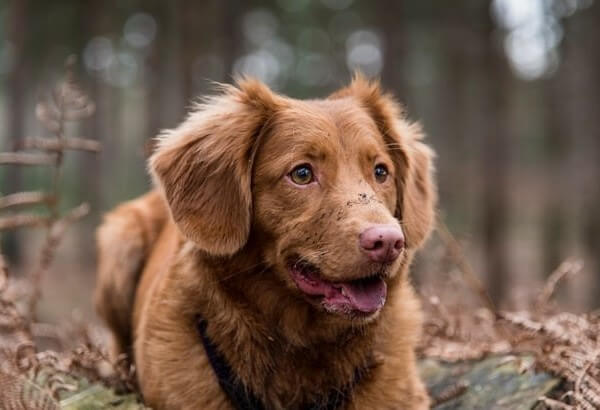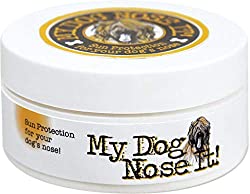
Our dogs use their nose to explore and experience the world around them. In fact, there are almost 300 million smell receptors inside our furry friend’s nose so their nose is able to smell 100,000 times better than a human’s nose. While most dogs have black noses, some dogs have pink spots on their noses or have all pink noses.
We will discuss why that is below, but first, let’s go over what dog breeds have pink noses.
Table of Contents
Dog Breeds With Pink Noses
You’ve probably seen some dogs with pink noses and wondered, “which dogs have pink noses?” Either through intentional breeding or occurring suddenly, there are certain dog breeds that have pink noses. Let’s find out!
What breeds of dogs have pink noses?

The pink nose is also called the liver nose. Below are 12 common dog breeds that have pink noses. They are listed alphabetically:
- Australian Shepherd
- Beagle
- Bernese Mountain Dog
- Bull Terrier
- Dogo Argentino
- English Springer Spaniel
- Golden Retriever
- Harlequin Great Danes
- Nova Scotia Duck Tolling Retriever
- Poodle
- Siberian Husky
- White Boxer
Why is my dog’s nose pink?
There are many reasons why your dog’s nose is pink. If you’ve always wondered, “How does a dog get a pink nose?” here are 7 main reasons.
1. Dogs with pink noses due to Dudley nose
Some dog owners may be worried or confused when their dog’s nose changes from its natural black or dark brown color to completely pink and stays pink permanently. This is known as the dudley nose condition.
There’s not enough research yet to know the cause behind the black to the completely pink nose color. You’ve probably seen a dudley nose Poodle or a dudley nose Pitbull. But what are other common dog breeds that have the dudley nose condition?
Here are 4 other dog breeds with dudley nose condition:
- Golden Retriever
- Doberman Pinscher
- Labrador Retriever
- White German Shepherd
The dudley nose condition can occur as the dog ages or it can be present right from birth. Puppies born with dudley nose condition don’t worry the owners as much as dogs born with black noses that change to pink permanently during their middle to senior age.
Owners of Labrador Retrievers should be aware that the dudley nose condition is very common in this dog breed. Like other dog breeds, Labrador Retriever puppies are born with pink noses. Within a few weeks, the presence of melanin kicks in and starts to turn the dog’s nose black.
However, some Labradors retain their pink noses even when they mature into adulthood. These dudley lab puppies will never have black noses even when they age. Adult Labs with pink noses are often known as dudley Labs.
There’s nothing wrong with a dog that has a dudley nose. In fact, the pink nose is just cosmetic and nothing to worry about since it doesn’t affect your dog’s health or daily life activities.
Dudley nose dogs are just as healthy as their black-nosed counterparts, however, the only thing that is different is that they are not able to participate in purebred shows since pink noses are not recognized as a quality breed standard.
It’s best to always stay vigilant and err on the side of caution by reaching out to your vet if your dog’s nose suddenly turns all pink. Monitor your canine friends closely for changes in the texture of his or her nose, nasal discharge, or behavioral changes.
You might also like: White Spot On Dog’s Nose – What Does It Mean?
2. Dogs with pink noses due to snow nose

Especially during the cold seasons like winter, our furry friends’ noses may lose color. Your pup’s nose was black or chocolate color and all of a sudden, it’s turning pink. If this is the case, your K9 friends may have snow noses.
Many researchers believe that during the cold season, a dog’s tyrosinase, or enzyme that is responsible for melanin production, is suppressed so the color of the nose gets lighter and it becomes pink.
Although snow nose usually happens during the colder months, it’s possible for dogs to have snow noses during warmer months as well.
Snow nose is seasonal. Your four-legged friends will have their regular black or chocolate nose back once the season is over.
While snow nose can happen to any dog breed, here are some common dog breeds that are prone to the snow nose condition:
- Bernese Mountain dog
- Golden Retriever
- Labrador Retriever
- Siberian Husky
Luckily, the snow nose condition is simply cosmetic and there’s no harm to your canine pals. However, as any responsible dog owner would, it’s best to monitor your dog’s nose closely and check for any other changes such as nasal discharge, dryness, flakiness, or sneezing. You’ll also want to confirm the condition with your vet and seek advice and suggestions.
3. Dogs with pink noses due to selective breeding
Another main reason for dogs with pink noses is genetics through selective breeding. Dogs with pink noses usually have a recessive liver gene and this recessive liver gene turns all of the black or dark brown pigmentation of a dog’s nose to that pink liver color.
Dog breed with the recessive liver gene will mostly have pink noses and will not have the typical dark black or brown pigmentation. You can also expect dogs with recessive liver genes to have red and brown fur as well as amber eyes.
Unfortunately, breeders have purposely chosen a few dog breeds (list below) to feature the pink nose through the recessive liver gene. As a result, these dog breeds have a pink or light brown nose, eyes, and even coats:
- Beagle
- English Springer Spaniel
- Nova Scotia Duck Tolling Retriever
- Poodle
- Siberian Husky
You may also be interested in: Teacup Husky – Complete Guide!
4. Dogs with pink noses due to butterfly nose
If you’ve seen dogs with either pink and brown markings or pink and black markings, then they most likely have butterfly noses. Some areas of the dog’s nose lack black pigments.
Genetics play a role here and butterfly nose is pretty common in dogs with merle and white coats.
You’ll most likely find butterfly noses in Harlequin Great Danes because they carry a gene that turns the dark pigmentations to pink or white, which is why they usually have pink noses.
There are also other dog breeds that can have butterfly noses. They include:
- Australian Shepherd
- Bull Terrier
- Dogo Argentino
- White Boxer
Fortunately, the butterfly nose is purely cosmetic and it doesn’t affect the dog’s health or daily life. However, make sure your dog is not outside under the sun for an extended period of time otherwise, they may be at risk of being sunburned on their nose and skin.
Owners will want to use a dog-specific sunblock spray or balm on their dog’s nose to prevent possible sunburn or damage caused by the UVA and UVB rays.
5. Dogs with pink noses due to health issues
As you can see, most dogs with pink noses are perfectly fine and healthy and the pink-colored nose is purely cosmetic.
However, there are times when a pink nose can warn you of potential health issues in your canine friends. There are two health issues you’ll want to be aware of. They are:
- Cutaneous Lymphoma.
- Discoid Lupus Erythematous.
Let’s go over each of them.
Cutaneous Lymphoma
Dogs with cutaneous lymphoma cancer will lose pigments on the eyelids, nose, and lips. When dogs lose their pigment due to cutaneous lymphoma, their nose starts to turn pink. Dogs with cutaneous lymphoma will experience the following symptoms so watch out for these and contact the vet immediately.
- Skin lesions.
- Face swelling.
- Nose swelling.
Discoid Lupus Erythematous
Discoid Lupus Erythematous is an autoimmune disease that causes dogs to lose pigment or have ulcerations on the nose. If you suspect your dog has a pink nose due to Discoid Lupus Erythematous, you’ll want to consult with your vet immediately. If this disease is left unattended or untreated, it can cause further tissue damage to the nose.
Autoimmune diseases like Discoid Lupus Erythematous as well as bacterial infections can cause a dog’s nose to turn pink or change the texture on the nose. If you notice crusty dry texture or nasal discharge, you’ll want to contact your vet immediately as this may require immediate medical attention.
6. Dogs with pink noses due to age
It’s pretty common for dogs to have reduced melanin production as they age. The once all-black nose may start to lose color and turn into pink. It can happen to any and all senior dogs. Since this is natural, it doesn’t affect the dog’s health or daily life activities and it is not a cause of concern or worry.
7. Dogs with pink noses due to allergies
Dogs can also have allergies and these allergies can affect the color of their nose. If you notice your dog’s nose turning pink or any nasal discharge, face or nose swelling, and sores, you’ll want to bring him or her to the vet for an examination and find the appropriate treatment for the allergies.
Another common irritant that can cause dogs to have pink noses is dirty plastic food or water bowls. Plastic food bowls usually retain dirt and debris and when your dog is eating their food, their nose touches the bowl and as a result, have dirt and debris on his or her nose.
Plastic bowls also contain chemicals that are harmful to our furry friends such as bisphenol A (BPA) and p-benzyl hydroquinone. The p-benzyl hydroquinone has been known to prevent melanin production in dogs so your pups may end up with pink noses.
Some dogs may have a plastic allergy and constant rubbing of their face or licking of their nose can cause pink noses.
We highly recommend that you switch over to stainless steel or ceramic food and water bowls for your precious pups.
Dogs With Pink Noses: Caring Tips
Most dogs with pink noses are perfectly fine and healthy and the pink noses are just cosmetic.
However, as we can see, there are some situations when dogs with pink noses require immediate medical attention.
If you notice a loss of pigmentation or color change on your dog’s nose, double-check to make sure it is not due to allergy, disease, or health issues. Some instances like bacterial infections and auto-immune disorders can cause a dog’s nose to turn pink.
Remember that a dog with a pink nose is often the result of a loss of pigmentation or reduced melanin production. Like us, humans also need melanin to protect their noses, lips, face, and skin from harmful UVA and UVB rays.
If your furry friends have pink noses, you’ll want to use sunblock lotions or spray specifically designed for dogs to prevent any sunburn to your dog’s nose.
Dogs With Pink Noses: final thoughts
If your pooch starts to have a pink nose, it’s best to err on the side of safety and visit the vet right away. Most dogs with pink noses are completely healthy and won’t experience any symptoms from it. That’s because some breeders intentionally bred dogs to have pink noses.
Other causes of pink noses in dogs include snow noses, butterfly noses, and dudley noses as mentioned above. As always, consult with your vet to confirm these conditions and ensure that it’s not a harmful health issue. It’s always better to be safe than sorry and getting a confirmation from your vet will provide you peace of mind.
DISCLAIMER: THIS WEBSITE DOES NOT PROVIDE MEDICAL ADVICE
The information, including but not limited to, text, graphics, images and other material contained on this website are for informational purposes only. No material on this site is intended to be a substitute for professional veterinary advice, diagnosis, or treatment. Always seek the advice of your veterinarian or other qualified health care provider with any questions you may have regarding a medical condition.
Resources:
https://bmcvetres.biomedcentral.com/articles/10.1186/s12917-018-1446-8
https://www.vetmed.wisc.edu/beach-water-dog-tips/

With over five years of specialized experience as an animal writer, my expertise lies in dog nutrition, health, behavior, grooming, and training. I am dedicated to delivering helpful and informative content that caters to the well-being of our furry friends. My primary goal is to empower pet owners with knowledge and ensure our canine companions thrive in health and happiness. In my free time, I love volunteering at local dog rescue centers.










